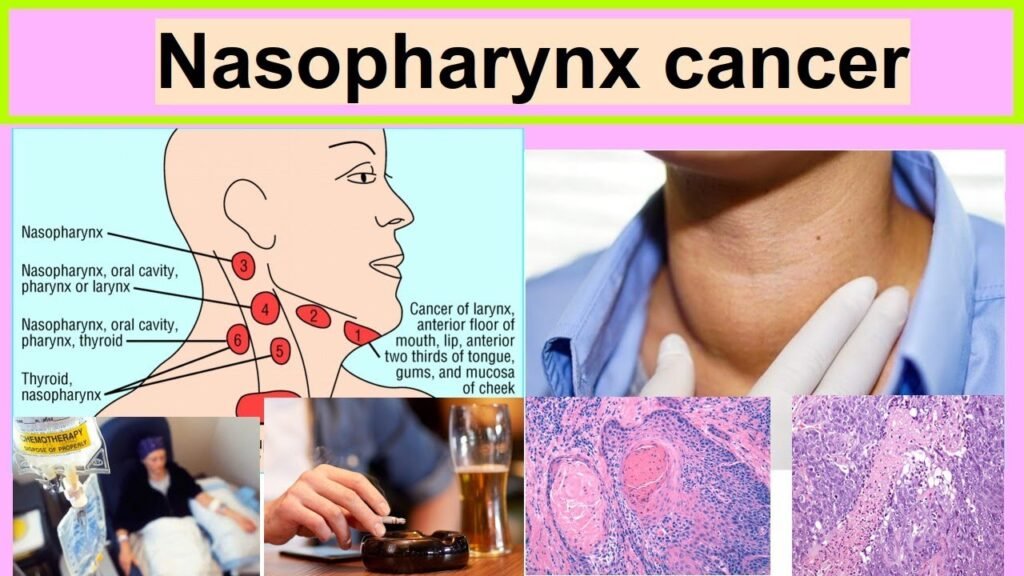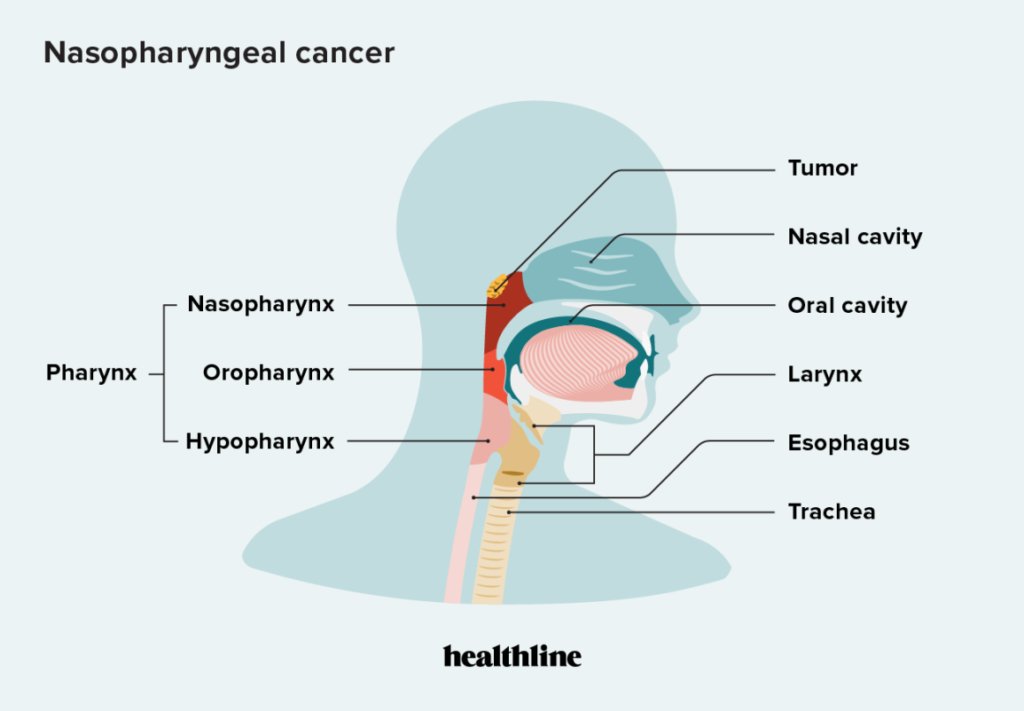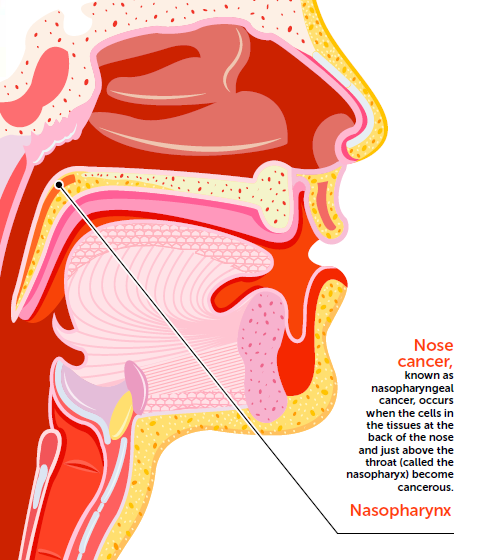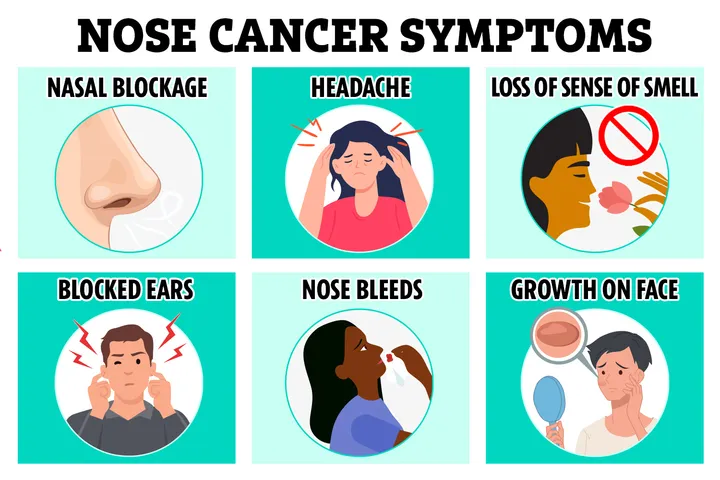
Nasopharyngeal cancer is a rare malignancy that originates in the nasopharynx, the area connecting the back of your nose to the back of your mouth. The most common symptom is a painless lump on the back of the neck, but it can also impact the ears, causing hearing loss or chronic ear infections, and may result in facial pain and numbness. Treatment varies depending on the cancer stage.
Overview

Nasopharyngeal cancer develops in the nasopharynx, situated just below the nasal cavity and above the oropharynx. This cancer starts when abnormal cells in the nasopharynx proliferate and form cancerous tumors, which can metastasize to the liver, lungs, and bones.
What is Nasopharyngeal Cancer?
Nasopharyngeal cancer (NPC), also known as nasopharyngeal carcinoma, is a rare type of head and neck cancer. It affects the tissue that connects the back of your nose to the back of your mouth, called the nasopharynx, located just above the roof of your mouth, at the base of your skull. Air flows through your nose, nasopharynx, and into your throat before reaching your lungs. NPC begins when abnormal cells in the nasopharynx grow uncontrollably, forming cancerous tumors that can spread to lymph nodes, liver, lungs, and bones.

Types of Nasopharyngeal Cancer
There are different tissues in the nasopharynx, each containing various cell types. Nasopharyngeal cancer subtypes are classified by the cell type affected, as per the World Health Organization (WHO):
- Keratinizing Squamous Cell Carcinoma (WHO Type 1): Cancer cells in the nasopharynx tissue that are covered with keratin.
- Nonkeratinizing Squamous Cell Carcinoma (WHO Type 2): Cancer cells in nasopharynx tissues that are not covered with keratin.
- Undifferentiated or Poorly Differentiated Carcinoma (WHO Type 3): Includes lymphoepithelioma and anaplastic variants. These cancer cells look very different from healthy cells under a microscope and grow and spread rapidly.
Is Nasopharyngeal Cancer Common?
In the U.S., nasopharyngeal cancer is rare, affecting 1 out of 100,000 people annually. It is more common in Asia, North Africa, and the Middle East. In the U.S., it typically affects individuals aged 15 to 24 and 65 to 79.

Symptoms and Causes
What are the Symptoms of Nasopharyngeal Cancer?
Common symptoms include a painless lump on the back of the neck, which can be one or multiple and usually not painful. Other warning signs are:
- Tinnitus (ringing in the ears)
- Hearing loss
- Ear fullness
- Persistent ear infections
- Headaches
- Stuffy nose
- Nosebleeds
- Difficulty opening the mouth
- Facial pain or numbness
- Breathing or speaking difficulties
These symptoms can resemble other less serious illnesses. If symptoms persist for more than two weeks or recur, consult a healthcare provider.

What Causes Nasopharyngeal Cancer?
The exact cause is unknown, but certain factors increase the risk:
- Heavy smoking and tobacco use
- Frequent heavy alcohol consumption
- Epstein-Barr virus (EBV) infection
- Diets high in salt-cured foods
- Exposure to dust and smoke
- Family history of the disease
- Higher prevalence in people from Southeast Asia, southern China, and northern Africa
- Men and individuals assigned male at birth (AMAB) are more susceptible
Diagnosis and Tests
How is Nasopharyngeal Cancer Diagnosed?
Diagnosis involves a family history review, physical exam of the nasopharynx, head, neck, mouth, throat, nose, facial muscles, and lymph nodes, and potentially a hearing test. Other tests include:
- Epstein-Barr virus test
- Biopsy
- CT scan
- MRI scan
- PET scan
What are the Stages of Nasopharyngeal Cancer?
Stages are determined by tumor size, location, and cancer spread:
- Stage 0: Affects only the top layer of cells inside the nasopharynx.
- Stage 1: Tumor has invaded nearby structures like the throat or nasal cavity.
- Stage 2: Cancer has spread to one or more lymph nodes on one side of the neck.
- Stage 3: Cancer has spread to lymph nodes on both sides of the neck.
- Stage 4: Tumor has spread to the skull, eye, cranial nerves, salivary glands, or lower throat and possibly to distant organs like the lungs or liver.

Management and Treatment
What are Treatments for Nasopharyngeal Cancer?
Treatment options depend on the cancer stage and may include:
- Radiation therapy
- Chemotherapy
- Chemoradiation (a combination of chemotherapy and radiation)
- Targeted therapy
- Surgery (though not usually the primary option due to the nasopharynx’s complex location, it may be used to remove unresponsive lymph nodes)
What are Treatment Side Effects?
Radiation and chemotherapy side effects vary. Palliative care can help manage these side effects.
Outlook / Prognosis
Is Nasopharyngeal Cancer Curable?
NPC can be cured if diagnosed before it spreads.
What is the Survival Rate for Nasopharyngeal Cancer?
The American Cancer Society reports a 63% five-year survival rate in the U.S. The prognosis improves if cancer is detected early:
- Local: 82% five-year survival rate
- Regional: 72% five-year survival rate
- Metastatic: 49% five-year survival rate
Survival rates are based on others’ experiences and can vary depending on age, health, and treatment response. Consult your healthcare provider for personalized information.
Living With
How Do I Take Care of Myself?
Healthcare providers can recommend ways to manage symptoms, alleviate pain, and enhance quality of life, such as:
- Eating a healthy, balanced diet
- Practicing mindfulness or meditation
- Joining a support group
What Questions Should I Ask My Healthcare Provider?
Questions to consider include:
- Has the cancer spread?
- What is the cancer stage?
- What are my treatment options?
- What side effects should I expect?
- Can treatment cure my cancer?
- How long will treatment last?
- What are the chances of recurrence?
- What will follow-up care involve?

A Note from Cleveland Clinic
Nasopharyngeal cancer is a rare head and neck cancer. While the exact cause is unknown, tobacco use, alcohol consumption, and family history may increase risk. Consult a healthcare provider if you are concerned about your risk. They can evaluate your health, assess your risk, and suggest preventive measures.



